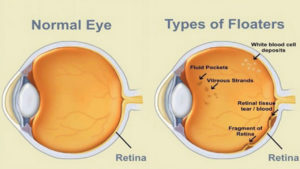Floaters aka Vitreous Opacities / Debris – By Brian Phillpotts, MD |
“I’m seeing little squiggly lines in my field of vision.”
“When I go outside, I see what looks like a spider darting across my line of sight.”
“I see strange little strands and speckles when I look at my computer screen.”
“At times, part of my vision looks like I’m looking through wax paper.”
These are just a few of the symptoms described by people who may be experiencing vitreous opacities, commonly called “floaters”. Floaters are very common and the vast majority (99%) require no treatment. However, it’s important to stay informed, so I’ve provided a few facts below about floaters.
DEFINITION OF FLOATERS
Floaters are shifting opacities of varying shapes, sizes and densities that appear in your field of vision. They are often seen in medium to bright light and/or against light colored walls, blue skies or light paper.
Floaters cast shadows onto the retina and appear as visual obstructions. They are usually only intermittent. Although they can be a bit of an annoyance, they are easily ignored and seldom require treatment. For most, they are not incapacitating while doing activities like driving, working, or exercising.

CAUSES OF FLOATERS
There are many things that can contribute to the onset of floaters. Here are a few:
- Aging
- Trauma
- Vitreous hemmorhage (diabetic retinopathy, retinal tear or retinal vascular occlusion/anomaly)
- Uveitis
- Endophthalmitis
- Lymphoma – B Cell
- Lens dislocation
- Amyloidosis – familial prealbumin
- Asteroid hyalosis
- Cholesterolosis
RISK FACTORS FOR FLOATERS
A few of the things that may increase the likelihood of getting floaters are:
- Age (50 and up)
- Smoking
- Sudden violent head movement or trauma
- Direct ocular trauma
Patients of all races present with floaters. They also don’t appear to impact one gender over another. Diet, sunlight exposure and cardiovascular risk factors are not known, but we recommend a healthy diet, polarized sunglasses and staying fit to all of our patients.

WHEN TO SEE A DOCTOR ABOUT FLOATERS
An annual eye exam is always recommended so that your eye doctor can carefully monitor any changes to the eye. With regard to floaters, special consideration should be given if you experience one or more of the symptoms below:
- Pain
- Decreased vision
- Flashing lights
- Visual field reduced
- Changes in vision following head trauma
- Increased number, duration or intensity of existing floaters
WHAT DO FLOATERS LOOK LIKE?
Here are some examples of how the vision of a person with floaters may be:




TREATMENT OPTIONS FOR FLOATERS
If you are concerned about floaters, we’re here to help. Of course every patient is unique, so treatment options vary greatly. Here are a few possible steps you can expect:
- A thorough examination by your doctor – he or she will give special attention to sudden onset, vision loss, reduced visual field, and pain.
- Careful observation as time passes – some floaters resolve on their own while in other cases, the patient finds it easier to tolerate them once the doctor determines they’re not vision threatening
- There are no “magic” eye drops, vitamins or pills that cure floaters
- If treatment is required, the doctor has options:
- Laser – using a laser to disrupt the floaters (while technically an option, we do not recommend this)
- Limited Vitrectomy or complete Vitrectomy – a surgical removal of the eye’s vitreous gel (this is rare, needed in less than 1% of cases)
Your doctor will discuss risks and benefits of treatment with you and together you’ll make a plan for the future of your vision. If you have any questions about floaters or if you’d like to schedule an exam, please call us today at 888-904-0000.









